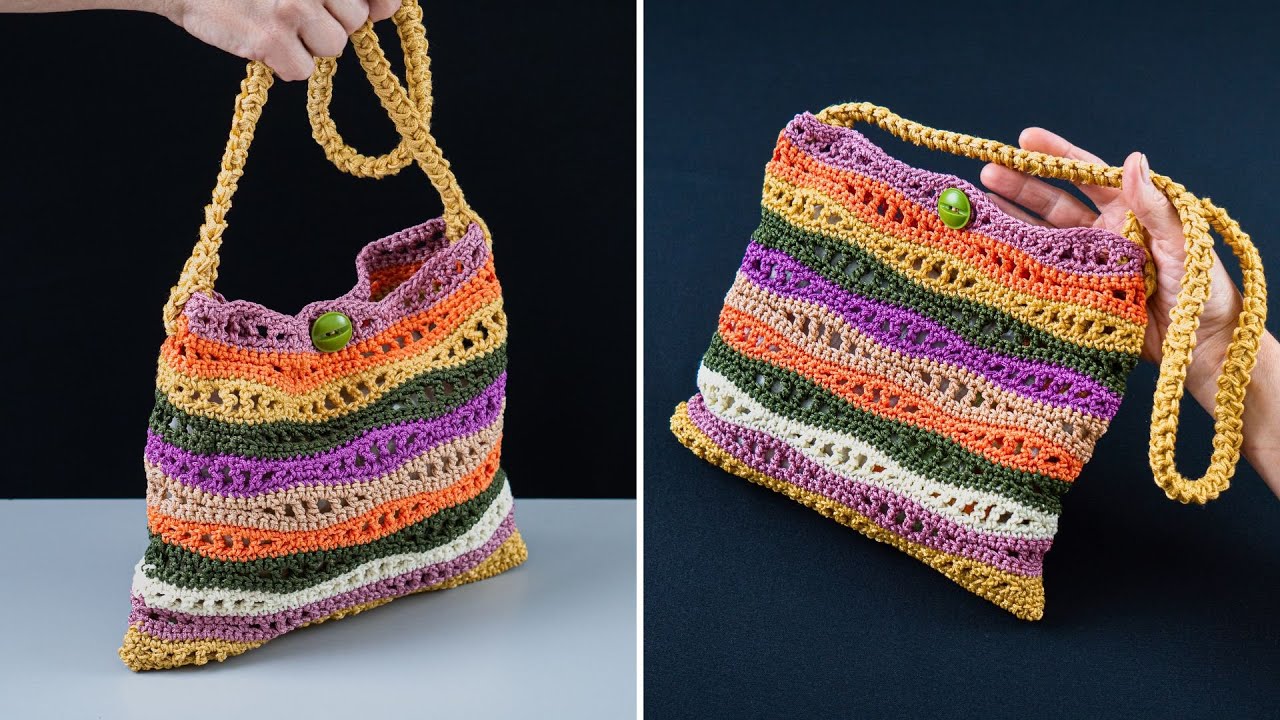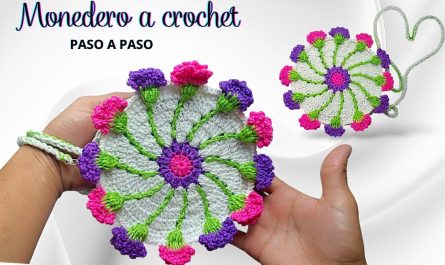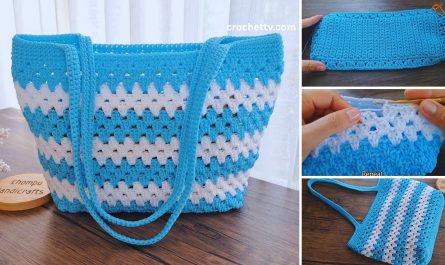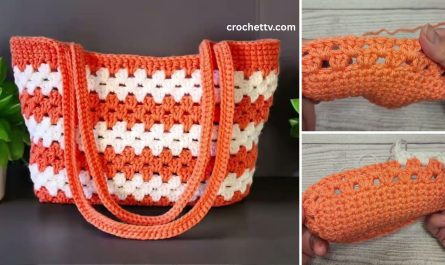Let’s crochet a vibrant and stylish Multicolor Crochet Waves Bag! This project is a fantastic way to play with color and texture, creating a visually interesting ripple or “wave” pattern. It’s also a practical and fun accessory you can customize to your heart’s content.
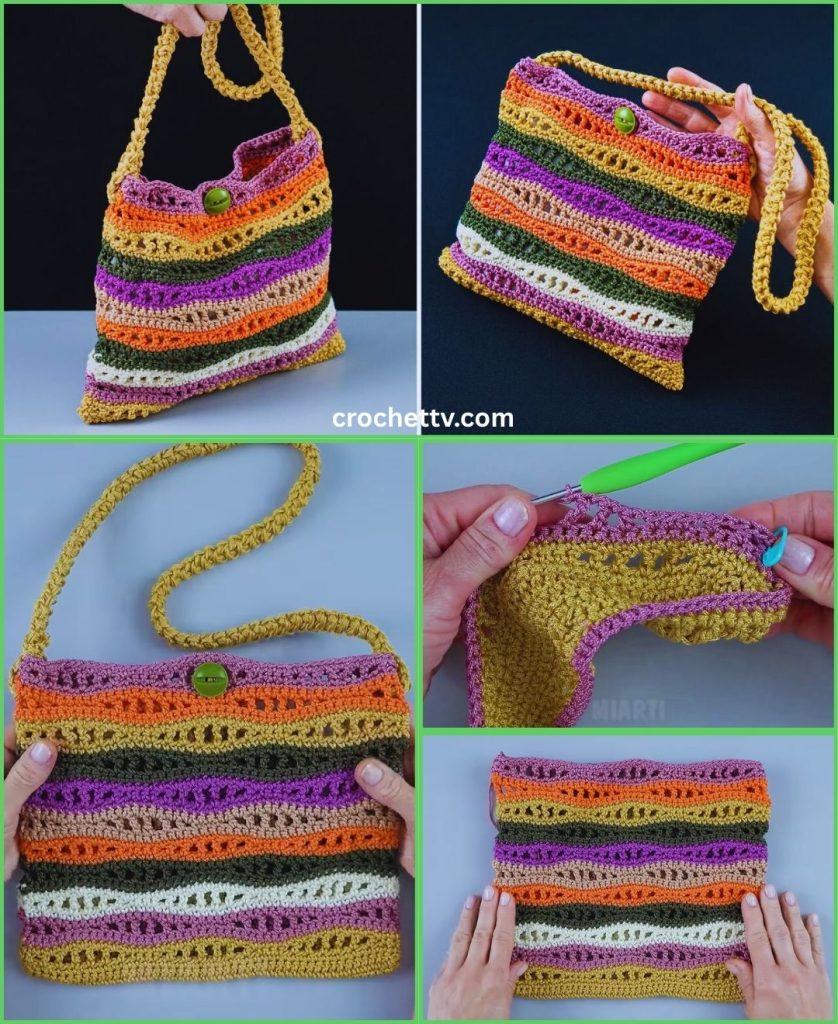
How to Make an Easy Multicolor Crochet Waves Bag
This detailed tutorial will guide you through creating a beautiful bag using a simple wave pattern, perfect for showcasing multiple yarn colors. We’ll build it from the bottom up, focusing on clean color changes and consistent wave formation.
Skill Level: Advanced Beginner / Intermediate
This project is ideal if you’re comfortable with:
- Chain (ch): The basic foundation.
- Slip Stitch (sl st): For joining rounds.
- Single Crochet (sc): A fundamental stitch.
- Double Crochet (dc): Used for the height of the waves.
- Working in rounds: Crocheting in a circular fashion.
- Color changes: Neatly switching between yarn colors.
- Fastening off: Securing your yarn.
- Weaving in ends: The essential finishing touch.
- Basic stitch counting/pattern following: The wave pattern requires attention to increases and decreases.
Finished Bag Dimensions (Approximate):
Using worsted weight yarn and the suggested hook, your finished bag will typically measure around:
- Base: 10-12 inches (25-30 cm) wide
- Height: 12-14 inches (30-35 cm) (excluding handles)
- Handles: Adjustable length
You can easily adjust the size of your bag by changing the starting chain length for the base or the number of rounds for the body.
Materials You’ll Need:
Gathering your materials beforehand ensures a smooth and enjoyable crocheting session.
- Yarn: Approximately 400-600 yards (365-550 meters) of Worsted Weight (Medium #4) Cotton or Cotton Blend Yarn.
- Why Cotton? Cotton yarn provides excellent stitch definition, durability, and less stretch, which is great for bags. It also allows the wave pattern to stand out beautifully.
- Color Choices: This is where the “multicolor” comes in! Choose 3-5 complementary or contrasting colors. Think about how they’ll flow together in waves. You’ll need about 100-150 yards of each color, depending on how many colors you use and how wide your stripes are.
- Example Palette: Dark Blue, Medium Blue, Light Blue, White, or Mustard Yellow, Terracotta, Cream, Sage Green.
- Crochet Hook: Size H/5.0mm. This hook size is generally good for worsted weight yarn, producing a sturdy fabric for your bag.
- Yarn Needle (Tapestry Needle): Essential for seamlessly weaving in all your loose yarn tails. It has a blunt tip and a large eye.
- Scissors: Any sharp pair of scissors.
- Stitch Markers (Optional but Recommended): Helpful for marking the first stitch of each round and the peaks/valleys of your waves, especially as you get used to the pattern.
Let’s Crochet Your Multicolor Waves Bag!
We’ll build this bag from the bottom up, starting with an oval base, then working the wave pattern up the sides, and finally adding the handles.
Understanding the Wave Pattern
The wave pattern is created by repeating a sequence of stitches that includes decreases (stitches worked together to create a dip/valley) and increases (multiple stitches worked into one stitch to create a peak). The number of stitches between peaks and valleys determines the width of your waves. For this tutorial, we’ll use a 10-stitch repeat, which means each wave segment (from peak to peak or valley to valley) will be 10 stitches wide.
The basic wave pattern for a single crochet base (adjusting for double crochet rows):
- Valley: sc2tog (single crochet 2 together) over the next two stitches.
- Building up: sc in next 4 stitches.
- Peak: 3 sc in the next stitch.
- Building down: sc in next 4 stitches.
- Repeat!
For a double crochet wave, the principle is the same, just with dc stitches.
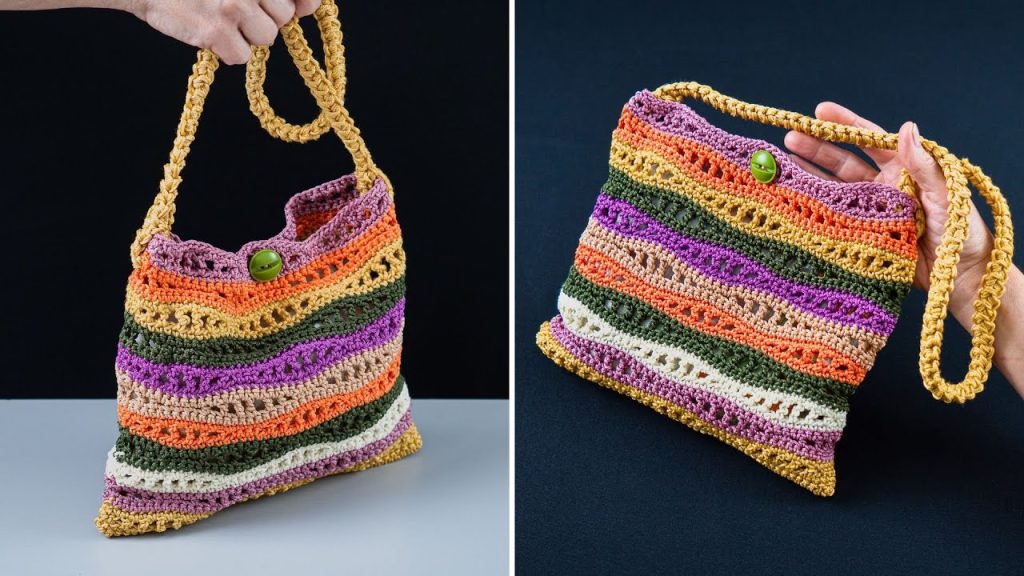
Part 1: The Oval Base (Start with your darkest or preferred solid color)
We’ll start by creating a sturdy oval base, which provides a good foundation for the bag.
- Starting Chain (with Color A):
- Make a slip knot with Color A and place it onto your H/5.0mm crochet hook.
- Chain (ch) 31. (This length determines the initial width of your bag. If you want a wider or narrower bag, adjust this chain. It should be an odd number.)
- Round 1 (Working around the chain):
- Work 2 single crochet (sc) stitches into the 2nd chain from your hook. Place a stitch marker in the first sc you just made (this will be the first stitch of your round).
- Work 1 sc into each of the next 28 chains.
- In the last chain (the 31st chain from your hook): Work 4 sc into this single chain. This turns the corner smoothly.
- Now, you’ll work back down the other side of your starting chain, into the bottom loops.
- Work 1 sc into each of the next 28 stitches.
- In the last stitch (the same chain where you put your first 2 sc): Work 2 sc into this chain. This turns the other corner.
- You should now have 64 sc stitches (2+28+4+28+2). Do NOT join with a slip stitch yet. You will be working in continuous rounds for the base to avoid a seam.
- Round 2 (Continuing the Oval Shape):
- Work 2 sc into the first stitch of the round (where your stitch marker is). Move your stitch marker to this new first sc.
- Work 1 sc into the next stitch.
- Work 1 sc into each of the next 28 stitches.
- Work 2 sc into each of the next 3 stitches.
- Work 1 sc into each of the next 28 stitches.
- Work 2 sc into each of the next 2 stitches.
- You should now have 72 sc stitches. Continue working in continuous rounds.
- Round 3 (Final Base Round – if desired, optional for a wider base):
- Work 2 sc into the first stitch of the round (where your stitch marker is). Move your stitch marker to this new first sc.
- Work 1 sc into the next 2 stitches.
- Work 1 sc into each of the next 28 stitches.
- Work 2 sc into each of the next 3 stitches.
- Work 1 sc into each of the next 2 stitches.
- Work 1 sc into each of the next 28 stitches.
- Work 2 sc into each of the next 2 stitches.
- You should now have 80 sc stitches.
- Stop here! When you finish the last sc of this round, remove your stitch marker.
- Slip stitch (sl st) into the first sc of this round to join. This flattens the end of the round and prepares for working up the sides.
- Fasten off Color A, leaving a 4-inch (10 cm) tail for weaving in.
- Note: The final stitch count for the base (80 stitches) must be a multiple of 10 for our wave pattern. If your count is different after making a larger base, adjust your starting chain and increases to ensure your final stitch count is a multiple of 10.
Part 2: Crocheting the Wave Pattern Body (Multicolor)
Now for the main attraction: the vibrant waves! We’ll work this in joined rounds.
- Round 4 (First Wave Round – with Color B):
- Join Color B with a slip stitch (sl st) into the same stitch where you just fastened off Color A.
- Chain 2 (ch 2 – counts as your first double crochet (dc)).
- Now, we start the wave pattern. The pattern repeats over 10 stitches. Since we have 80 stitches, we’ll have 8 wave repeats around.
- Work dc2tog (double crochet 2 together) over the next 2 stitches. This creates a valley. (Yarn over, insert hook into next st, pull up a loop (3 loops on hook); yarn over, pull through 2 loops (2 loops on hook). Yarn over, insert hook into next st, pull up a loop (4 loops on hook); yarn over, pull through 2 loops (3 loops on hook); yarn over, pull through all 3 loops.)
- Work 1 dc into each of the next 3 stitches.
- Work 3 dc into the next stitch. This creates a peak.
- Work 1 dc into each of the next 3 stitches.
- Work dc2tog over the next 2 stitches. This brings you back to a valley.
- *Work 1 dc into each of the next 3 stitches. Work 3 dc into the next stitch. Work 1 dc into each of the next 3 stitches. Work dc2tog over the next 2 stitches.*
- Repeat from * to * around the entire round until you reach the beginning ch 2.
- Slip stitch (sl st) into the top of the beginning ch 2 to join the round.
- Do NOT fasten off Color B yet! You will make a second wave round in the same color to make the stripe wider.
- Round 5 (Second Wave Round – with Color B):
- Chain 2.
- Work dc2tog over the next 2 stitches (these will be the two stitches directly above the dc2tog from the previous round).
- Work 1 dc into each of the next 3 stitches.
- Work 3 dc into the next stitch (this will be the middle dc of the 3 dc peak from the previous round).
- Work 1 dc into each of the next 3 stitches.
- Work dc2tog over the next 2 stitches.
- Repeat from * to * (the same pattern as Round 4) around the entire round.
- Crucial Step: Color Change! When you make the very last dc2tog of this round, stop when you have three loops left on your hook.
- Drop Color B. Pick up Color C.
- With Color C, yarn over and pull through all three loops on your hook to complete the stitch. Color C is now active on your hook.
- Now, complete the round by doing a slip stitch (sl st) with Color C into the top of the beginning ch 2 you made at the start of this round.
- Fasten off Color B, leaving a 4-inch (10 cm) tail for weaving in.
- Continue the Wave Pattern (Alternating Colors):
- Repeat Rounds 4 and 5, alternating your chosen colors. For instance:
- Rounds 6 & 7: Work in Color C. At the end of Round 7, change to Color D.
- Rounds 8 & 9: Work in Color D. At the end of Round 9, change to Color E.
- Rounds 10 & 11: Work in Color E. At the end of Round 11, change to Color A.
- Continue this pattern until your bag reaches your desired height (e.g., 10-12 rounds after the base). Keep the stitch count at 80 stitches per round (or whatever multiple of 10 you started with).
- Always ensure your color change happens on the last stitch (the dc2tog) of the second round of each color stripe.
- End with the color you want your handles to be (often the same as your base color, Color A, or a complementary color).
- Repeat Rounds 4 and 5, alternating your chosen colors. For instance:
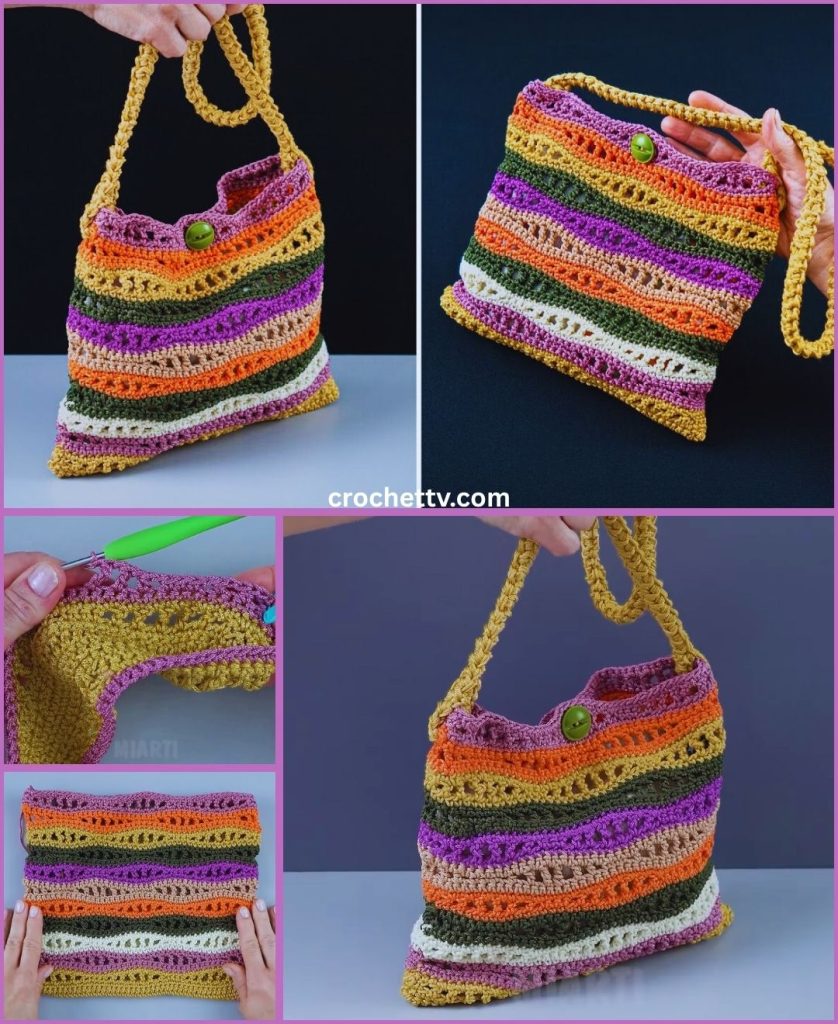
Part 3: Creating the Handles (Last Active Color, e.g., Color A)
The handles will extend from the top of your bag, integrating with your final color choice.
- Round (or Row) for Handle Placement:
- After your last wave round (with your final desired color active on your hook, e.g., Color A), chain 1 (does not count as a stitch).
- Work 12 single crochet (sc) stitches. (This places the stitches for the first attachment point).
- Chain 30 (ch 30 – this creates the length of your first handle. Adjust this number to make the handle longer or shorter).
- Skip the next 16 stitches (this creates the opening for the bag).
- Work 24 sc stitches (this will take you across the front/back to the other side for the second handle).
- Chain 30 (ch 30 – this creates the length of your second handle).
- Skip the next 16 stitches.
- Work 12 sc stitches (this should bring you back to the start of the round).
- Slip stitch (sl st) into the first sc of this round to join.
- Round for Handle Finishing (Strengthening):
- Chain 1.
- Work 1 sc into each of the 12 sc stitches from the previous round.
- Now, work 30 sc stitches around your chain-30 handle loop. Make sure to work into the chain itself and not just the top.
- Work 1 sc into each of the 24 sc stitches between the handles.
- Work 30 sc stitches around the second chain-30 handle loop.
- Work 1 sc into each of the remaining 12 sc stitches.
- Slip stitch (sl st) into the first sc of the round to join.
- Fasten Off:
- Cut your yarn, leaving a 6-inch (15 cm) tail.
- Yarn over with your hook, pull the cut tail completely through the loop left on your hook, and gently tug to secure the knot.
Part 4: Final Finishing Touches
- Weave in All Ends:
- This is the most crucial step for a neat, professional-looking bag. You’ll have tails from your starting chain, all your numerous color changes, and the final fasten-off.
- Use your yarn needle to meticulously weave in every single loose yarn tail.
- How to Weave Neatly: Thread the yarn tail onto your yarn needle. Weave the tail into the stitches of the same color as the tail. Go in one direction for at least 1-2 inches (2.5-5 cm). To truly secure it, subtly change direction (e.g., weave along a stitch, then turn and weave back through some of the same stitches diagonally or perpendicularly) to “lock” the tail in place and prevent it from unraveling. Trim any excess yarn close to the fabric, being careful not to cut any of your actual stitches.
- Blocking (Optional):
- Blocking can significantly improve the drape, even out any tension inconsistencies, and give your bag a more polished, professional look.
- Method: Gently mist the bag evenly with cool water using a spray bottle until it’s damp but not soaking wet. Stuff the bag lightly with tissue paper or a clean towel to help it hold its intended shape. Allow the bag to air dry completely and thoroughly in a well-ventilated area.
- Optional: Bag Lining:
- For extra durability and to prevent small items from slipping through the stitches, consider adding a fabric lining. This is a separate sewing step. Measure the finished dimensions of your crocheted bag. Cut fabric pieces slightly larger, sew them into a matching pouch, and then hand-stitch or machine-stitch it inside your crocheted bag.
Congratulations! You’ve successfully crocheted a beautiful and unique Multicolor Crochet Waves Bag! This project not only results in a lovely accessory but also helps you master working with increasing and decreasing stitches to create dynamic patterns. Enjoy your stunning, handmade bag!

